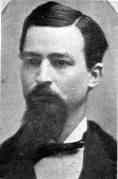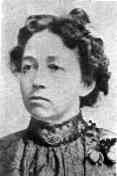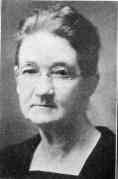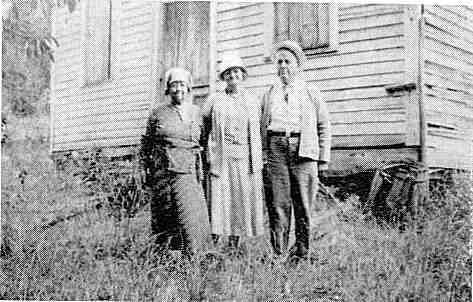<p.7>
The Richardson Family
A Sketch of the Lives of Solomon and Elizabeth Richardson, Pioneers of Oregon
BY MARY E. COLBY
In writing this sketch of the lives of my parents I am giving it as I have heard them relate it. There was no diary kept, so it is all from memory.
Solomon Richardson was born August 27, 1813, in Cumberland county, Kentucky, near Burksville, the county seat, in the southwestern part of the state.
His father, Shadrach Richardson, was a native of Virginia, as was his grandfather. His great grandfather came over from England before the Revolution and the son (Solomon's grandfather) was a soldier in the Revolutionary war. After the war the family emigrated to Kentucky. The oldest son, Shadrach Richardson, was a soldier in the war of 1812. In fact he was one of the 300 Kentucky riflemen with Jackson at the battle of New Orleans January 8, 1815. The Kentucky rifle, with the shot pouch and powder horn, were brought across the plains by Solomon Richardson in 1847, and I believe the shot pouch and powder horn are still in existence and in the possession of Ward K. Richardson, a grandson.
Shadrach Richardson and wife (whose maiden name was Mary Elizabeth Garret) raised a family of twelve children, seven sons and five daughters. Solomon, the subject of this sketch, was the fifth son. At the age of 19 he went with his father's family to Illinois, where he remained ten years.
Following the death of his mother Solomon started cut in life for himself, going to Iowa Territory, where he settled in Van Buren county, near Pittsfield, He built a cabin on his claim and as it was the largest house in the neighborhood, and as he was a bachelor and there was no public building, his home was always open to public gatherings. Sometimes there were dances, and sometimes preaching of any and all denominations and often the housewives would hold a quilting bee. Frequently families coming in late in the fall would winter with him.
It thus came about that in the fall of 1841 Abraham Trullinger, coming from Indiana to settle in the then new country of Iowa, spent the winter at the home of Solomon Richardson. The frontier home of the Iowa bachelor thus became welcome shelter for the Trullinger family.
Now, there must always be some romance in every story, and in this one it came about that on June 14, 1842, Elizabeth Trullinger became the bride of Solomon Richardson.
As this pioneer history is one of the life and experience of both Solomon and Elizabeth, we will revert a short time and give something of her ancestry.
The Trullinger family, or as it was then pronounced Drullinger, came to America from Holland and settled in Pennsylvania before the Revolution. I do not remember to have heard much of the early history of the Trullinger family, except that in the course of time the descendants kept moving on west. It is then we come to Abraham Trullinger (I believe he must have been about the third generation) and his wife Margarette Trullinger, who had borne the same family name before her marriage, being a cousin of Abraham. They settled near Attica, Fountain county, Indiana. There were born to them twelve children, nine of whom reached maturity. Elizabeth, the third daughter and the fourth child, was born April 19, 1823, near Attica, Fountain county, where she grew to womanhood, and in the autumn of 1841 went with her father's family to Iowa.
<p.8>
She was married the following spring to Solomon Richardson, June 14, 1842. On November 8, 1843, James, their oldest son, was born, and July 14, 1846, John, the second son, arrived.
About this time there was much excitement about the Oregon country. Solomon was ever ready to try pastures new and he began to make preparations for the long journey across the plains. He wished to visit relatives in Illinois before making the long journey. In the fall of 1846 he and his brother, George, and their families went back to Illinois to settle up the family estate (their father having died) and to bid farewell to the brothers and sisters there.
The day before they were to set out on their return to Iowa, David Gish, a brother-in-law, proposed a quail hunt. That was the popular sport at that time of the year, and he wished to have one last hunt together before the boys left. Near the close of the day the horse upon which Dave Gish was riding threw the rider against a tree, killing him instantly. It was a sad ending of a day of sport. They remained until after the funeral before starting back to Iowa. It was a sad parting with the widowed sister and her three children, whom they never saw again.
The necessary preparations for the long journey were made during the winter and spring of 1847. In May they started on that long journey to Oregon. The company consisted of only two families at the start, Solomon and his family, with J. T. Jacob, a young Englishman as a stock driver; George Richardson, wife and family of three children, with Sol and Elisha Williamson, brothers of George's wife.
They were soon joined by others. I do not remember the names of all, only the ones who remained friends and neighbors in later life. There were the Dillons, William and Juniper, with their families, and the Grahams, David, a single man and William and wife-, Melichi Johnson and family. There were others I have heard my father mention but I can not tell whether they crossed the plains together or were their early pioneer neighbors.
The early days of the journey were without any particular incident until June 25, on the Great Platte, they had their first runaway. James, the oldest eon of Solomon, was killed by a wagon runnning over him. The little fellow lived but a few hours after the accident. That was, I think, the first death in the company. The train laid by for half a day and buried the child, and some man in the company carved his name, age and date of his death on a board with a pocket knife and placed it at the head of the grave. And thus they left their first born in the wilderness, never to see the spot again.
The next year my mother met a woman who had seen the grave. This woman said that she had camped at the place and read the name on the head board. There was another grave of about the same size beside it, she said. So they had the comfort of knowing that the grave had not been disturbed by the Indians as they sometimes were.
There was no serious trouble with the Indians, although several times there were indications of attack. The Indians would come and act very very friendly, as they usually did before an attack, but would see that the men all carried guns and were ready for an emergency. One time in particular I have heard my parents say they would have been attacked. Fortunately they were joined that evening by another train of eight wagons, and the Indians feared that the two trains were too strong for them.
The buffalo were running on the Platte at the time the train passed through that country and they had quite a time guarding the stock to keep them from running away with the buffalo.
After the plains there was a long, dreary stretch through the wilderness with a scarcity of food and water. Work cattle began giving out and dying by the wayside. The members of the train began to lighten loads by leaving behind everything they could possibly do without. There was one elderly lady in the company who was determined to keep her rocking chair. The men folks would not put it on the wagon when they were breaking camp in the morning. She would take it up and start on walking, carrying the chair with her and after a short
<p.9>
time the men would repent and put it on the wagon. This would happen every time they attempted to leave it. The woman won out and got the chair across and enjoyed it after settling in Oregon.
It was November when the worn out train reached the Willamette valley. Solomon Richardson and the Dillons spent the winter at the home of James Johns, after whom St. Johns is named. There on December 3, 1848, the third son, Milton, was born. George Richardson and the Grahams wintered at Lynn City (near Oregon City). Other members of the company scattered out to different places. The Johnson family settled in Polk county, near Bethel. Later Solomon Richardson moved to Linnton.
In 1848 Daniel Trullinger, an uncle of Elizabeth Richardson, with his family of ten children, came to Oregon and settled on the Molalla. In the spring of 1849 Solomon Richardson and several others of the 1847 immigration went to the gold mines in California, leaving their families in Oregon.
He returned home in the fall of the same year, having been sick a great part of the time he was in the gold fields. During the time he was able to work, however, he made good money.
In the spring of 1850 he located on a donation land claim in Washington county, on the Tualatin river bottom, just south of what is now Tigard. His brother George and the Grahams had located in the same locality the previous year. It was on this claim that the family grew up and the mother and father spent the remainder of their lives.
Mr. Richardson cut 14 large trees to make an open space to build there. The claim was covered with large fir timber, and in the heart of this virgin forest he carved out a farm. The country around was soon settled, however, as there was a heavy immigration in the early '50s.
On September 30, 1852, the first daughter, Margarette, was born, and April 1, 1854, the second daughter, Olive, was born. By this time the community had grown so that a school district was organized, called Butte District No. 23. In the little log school house built in the district the children of Solomon and Elizabeth obtained their education.
Mr. Richardson was justice of the peace in the early days, and was also clerk of the school district. Upon his retirement from that office his son Milton succeeded him and held the position for a number of years.
On June 25, 1858, Mary Ellen, the third daughter and the last child, was born, just 11 years after the death of James, the oldest child.
In 1857 Solomon Richardson decided to leave the original log cabin which had housed his family since settling on the claim. A frame house was erected on the sloping hillside northwest of the first cabin. It was not finished, however, until several years later. At that time all lumber had to be dressed by hand and building a house took months.
During the early years the life of the Oregon pioneers was a very busy one. Neighbors depended on one another in sickness and distress. And Solomon Richardson was never too busy to go to help anyone in need of assistance. As there was no undertaker at that time any nearer than Portland, he was often called when death visited the neighborhood to perform that service and see to funeral arrangements. In times of sickness both he and Elizabeth were always ready to go to help take care of the sick.
Through all his long and useful life he never had a row with a neighbor.
The years passed with their joys and sorrows. The children all grew to manhood and womanhood. The first break in the family circle was the marriage of the oldest daughter, Margarette, July 27, 1871, to John L. Mitchell, a native of New York. The second daughter, Olive, was married on January 3, 1875, to Rufus Norman, a native of West Virginia.
John, the oldest son, was married March 28, 1878, to Mary E. Speak, a native of Missouri, who had come across the plains as an infant with her parents in 1852. The third daughter, Mary Ellen, was married to William E. Colby on November 5, 1882. Milton was married April 14, 1889, to Alice Hibbs at McMinnville.
Elizabeth Richardson died on December 24, 1883, having completed her three score years. The last 13 years of her life she was an invalid. Solomon Richardson died May 5,
<p.10>
1888, lacking only a few months of completing his 75th year. Both rest in the Crescent Grove cemetery in the neighborhood where they spent so many years of their long, useful lives. Here also rest many of their neighbors who had lived their lives in those stern pioneer times together. In thinking of them these beautiful lines come to my mind: "And here they rest, their earthly life is done. But in the mansion of the blest, their life is just begun."
Of the five children who survived this pioneer couple only one is now living (1940), the youngest daughter, Mary Ellen.
Olive Norman was the first to answer the summons. She died December 18, 1896, at the old homestead which had been her home for some years. Eight months later, September, 1897, her husband Rufus Norman passed away, the victim of a harvesting accident. Four children survived them--Rufus, Ethel, Eva and Hattie. Only one is now living, Ethel Norman now a resident of Oakland, California. There were no grandchildren in this branch of the family.
Margarette Mitchell died April 11, 1911, at Arcata, Calif., where she had made her home for many years. Her husband has since joined her in the great beyond. Of her children one is still living, Edith Tomlinson of Arcata, Calif. John Herbert, the oldest son died in January, 1928. Frank C. Mitchell, who had resided at Biggs, Calif., died Sept. 11, 1939, while on a visit with his sister, Mrs. Tomlinson. Frank is survived by his widow and two daughters, Mrs. Vera Harry of Biggs and Mrs. Beryl Halstead of Oroville, Calif.
John answered the final summons December 9, 1911, at Portland. His wife passed away on June 26, 1914, at Portland. Their three children, one son and two daughters are still living. They are Clyde S. Richardson, 731 S. W. Bancroft Terrace, Portland, Mrs. Minnie E. Overlin, and Laura E. Richardson, both of Portland. Clyde has a family of a wife and two sons, John and Clyde Jr., both of Portland. Minnie has one daughter, Mary Overlin.
Milton passed away June 5, 1919, at McMinnville, where he had lived for many years. His widow followed him in death eight years later, dying at the home of her son Ward in Salem on July 6, 1927. Both lie buried in the Masonic cemetery at McMinnville. Shadrach Richardson, a son of George and a cousin of the Solomon Richardson children, and his wife Charity A. Richardson, made their home in McMinnville as close neighbors to Milt Richardson. Shadrach died in the spring of 1912 and was cremated. Charity died in the winter of 1916 and is buried in the McMinnville Masonic cemetery.
Milton and Alice Richardson were the parents of two sons, Ward K. Richardson who was born August 2, 1890, and Earle Richardson, born November 25, 1895, both near McMinnville. Ward resides on a ranch near Falls City. His family consists of a wife, Vera Chenoweth Richardson and a daughter Katherine Alice, born August 29, 1926. Earle has lived in Dallas since March 1, 1924. He married Beth Stewart at McMinnville on September 14, 1921. They have one daughter, Vivian Eileen, born at Dallas, August 3, 1928.
John and Clyde Richardson Jr. are the only great grandsons of Solomon Richardson who are living. There were no grandsons bearing the name of Richardson in the George Richardson family.
One daughter Mary Ellen Colby (myself) is the only child of Solomon and Elizabeth Richardson still living. She was married November 5, 1882 in Portland, Oregon, to William E. Colby, a native of Vermont. The first winter after their marriage they lived in Portland. In the spring of 1883 they went to Toledo, Washington, a small town on the Cowlitz river. There Mr. Colby established a ferry which he operated for six ,years. Here their only child, a daughter Hattie was born July 13, 1885. In the spring of 1889 Mr. Colby sold the ferry and other property and moved to McMinnville, Oregon, where he bought a tract of land south of town in the Booth Bend community and erected a home. The family lived there until his death June 22, 1892. On July 22, 1895, just three years and one month after Mr. Colby's death the daughter Hattie passed away. They are buried in the Masonic cemetery near McMinnville.
<p.11>
Since the death of her husband and daughter Mrs. Colby has resided in McMinnville. For several years she ran a boarding house and then took up the occupation of nursing which she followed until she retired because of her age. She is still living in McMinnville and is now (1940) in her 82nd year.




